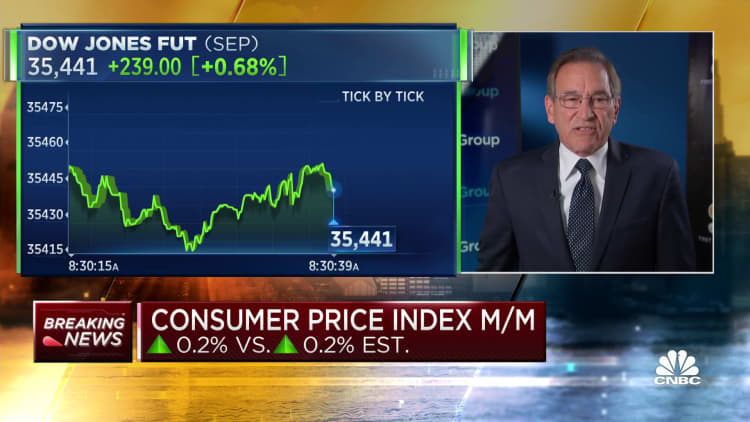Inflation gauge rose 3.2% annually in July, less than expected
 [ad_1]
[ad_1]

The consumer price index rose 3.2% from a year ago in July, a sign that inflation has lost at least some of its grip on the U.S. economy.
Prices accelerated 0.2% for the month, in line with the Dow Jones estimate, the Bureau of Labor Statistics reported Thursday. However, the annual rate was slightly below the 3.3% forecast though higher than June.
Excluding volatile food and energy prices so-called core CPI also increased 0.2% for the month, equating to a 12-month rate of 4.7%. The annual rate for core also was slightly below a Dow Jones consensus estimate for 4.8%.
Markets reacted positively to the report, with futures tied to the Dow Jones Industrial Average up nearly 200 points and Treasury yields mostly lower.
Almost all of the monthly inflation increase came from shelter costs, which rose 0.4% and were up 7.7% from a year ago. The BLS said more than 90% of the increase came from that category, which accounts for about one-third of the CPI weighting.
Food prices increased 0.2% on the month, and the BLS said energy increased just 0.1% even though crude prices surged during the month and prices at the pump jumped as well.
Used vehicle prices declined 1.3% and medical care services were off 0.4%.
The comparatively tame inflation levels helped raise worker pay. Real wages increased 0.3% on the month and were up 1.1% from a year ago, the BLS said in a separate release.
The annual rate for headline inflation, while below expectations, actually marked an increase from the 3% level in June.
Together, the latest batch of data shows that while inflation has come well off its 40-year highs of mid-2022, it is still considerably above the 2% level where the Federal Reserve would like to see it and high enough that cuts in interest rates are unlikely anytime soon.
"While inflation is moving in the right direction, the still-elevated level suggests that the Fed is some distance from cutting rates," said Seema Shah, chief global strategist at Principal Asset Management. "Indeed, disinflation is unlikely to be smooth and will require some additional economic pain before the 2% target comes sustainably into view."
Decelerating levels, though, are at least taking some of the pressure off the Fed to keep tightening policy.
After hiking benchmark interest rates 11 times since March 2022, central bank officials are widely expected to take a break in September. However, it's up for debate what happens from there, and public statements from policymakers have shown disparate opinions.
Earlier this week, regional Fed presidents John Williams of New York and Patrick Harker of Philadelphia made comments indicating they could see the rate hikes at an end. However, Governor Michelle Bowman said she expects more increases, while fellow Governor Christopher Waller also has pointed towards the possible need for additional hikes ahead.
Regardless of whether the Fed approves any additional hikes, virtually all members have agreed that the higher rates are likely to stay in place for some time.
This is breaking news. Please check back here for updates.
Comments
Post a Comment